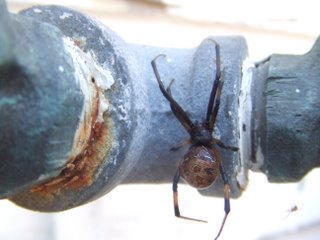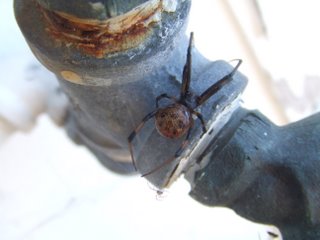

This morning I went to turn on the hose to fill up the fish pond and I nearly put my hand down on this spider (above). It was actually quite large and I cam pretty close to grabbing it in my attempt to turn on the water. It was only after that I had jerked back that I realized that she was surrounded by tiny replicas. One of them can be seen near the large spider's back legs. Initially, I thought it was a harmless spider but on closer eximination we spotted the telltale hourglass on her abdomen. So, it was a widow spider. However, it didn't look anything like the black widow that I had discovered at work a couple months ago. This one was mottled brown and cream with striped legs. After a bit of internet research, I decided that this was probably a brown widow, based off of the pictures (below). Unfortunately, I discovered that brown widows inhabit the mostly southeastern areas of Florida, Texas, and Alabama, not Orange County, California. Until I read that article down below. It seems that a fourth grader from Torrance (Los Angeles) sent in a spider that she had collected to the Natural History Museum. It was identified as a brown widow. This non-native likely caught a ride aboard a fruit shipment from Florida or Texas and found California to a prime spot for living (much like many of the people that live here). The spiders have been found, with increasing frequency, throughout Los Angeles and Orange Counties. Bummer. I popped our specimen into the freezer and Chris sprayed the babies with bug killer. As much as I like the fact that spiders eat the mosquitos that tend to make evenings uncomfortable, I was not very eager about a potentially harmful batch of spiders living on my hose.


The Brown Widow in Southern California
In February of 2003, specimens of the non-native brown widow spider, Latrodectus geometricus, were discovered as part of the Los Angeles Spider Survey being conducted by the Los Angeles County Museum of Natural History. This was an interesting discovery and one that is mostly of scientific interest to southern California arachnologists.
However, the ensuing media attention that was given to the spider has created the false impression that the brown widow is a new danger in southern California. Reports have correctly stated that the spider's venom is fairly potent but because the spider injects so little, it is not of major consequence. Yet one hyperbolic report stated that the spider hasn't killed anyone so far. This is not surprising because the brown widow is not a dangerous nor deadly spider. Even though it has venom of high toxicity, this is typically determined with injections of venom into mice or rabbits and conclusions from this are inferred with little real-world relevance. Much more relevant is the effects of actual spider bites. A South African medical journal reports on the bites of 15 brown widows in humans (Müller 1993) . Only two symptoms of brown widow envenomation were reported in the majority of bite victims: 1) pain while being bitten and 2) a mark where the bite occurred. That's it. Not much more. The bite of the brown widow is about the same as any non-poisonous spider. It hurts and leaves a little mark on the skin. It is no big deal. There are none of the serious, protracted symptoms that one would exhibit when bitten by a black widow.
So even though the non-native brown widow is virtually harmless, it is getting all this publicity and people are concerned about it. The hyperbolic response of the media and the general public to this new resident of southern California is ludicrous considering there are millions (maybe billions) of native black widows, Latrodectus hesperus, all over southern California, which have a far more poisonous venom than the brown widow, poses a much greater potential danger due to its great numbers and venom toxicity than the brown widow could ever hope to pose, black widow bites do occasionally happen, no one dies, people see black widows all the time, kill them and are not particularly concerned about them. Yet you don't see media articles about the black widow because it isn't "news".
The brown widow is not a spider of medical concern and is not likely to become one. It isn't dangerous where it currently lives and there is no reason to believe that all of a sudden it will become dangerous now that it is in southern California. The native black widow is still the major spider of potential medical importance in southern California, always has been and always will be here.
Reference:
Müller, G. J. 1993. Black and brown widow spider bites in South Africa. South African Med J. 83:399-405.
The original article can be found here.
